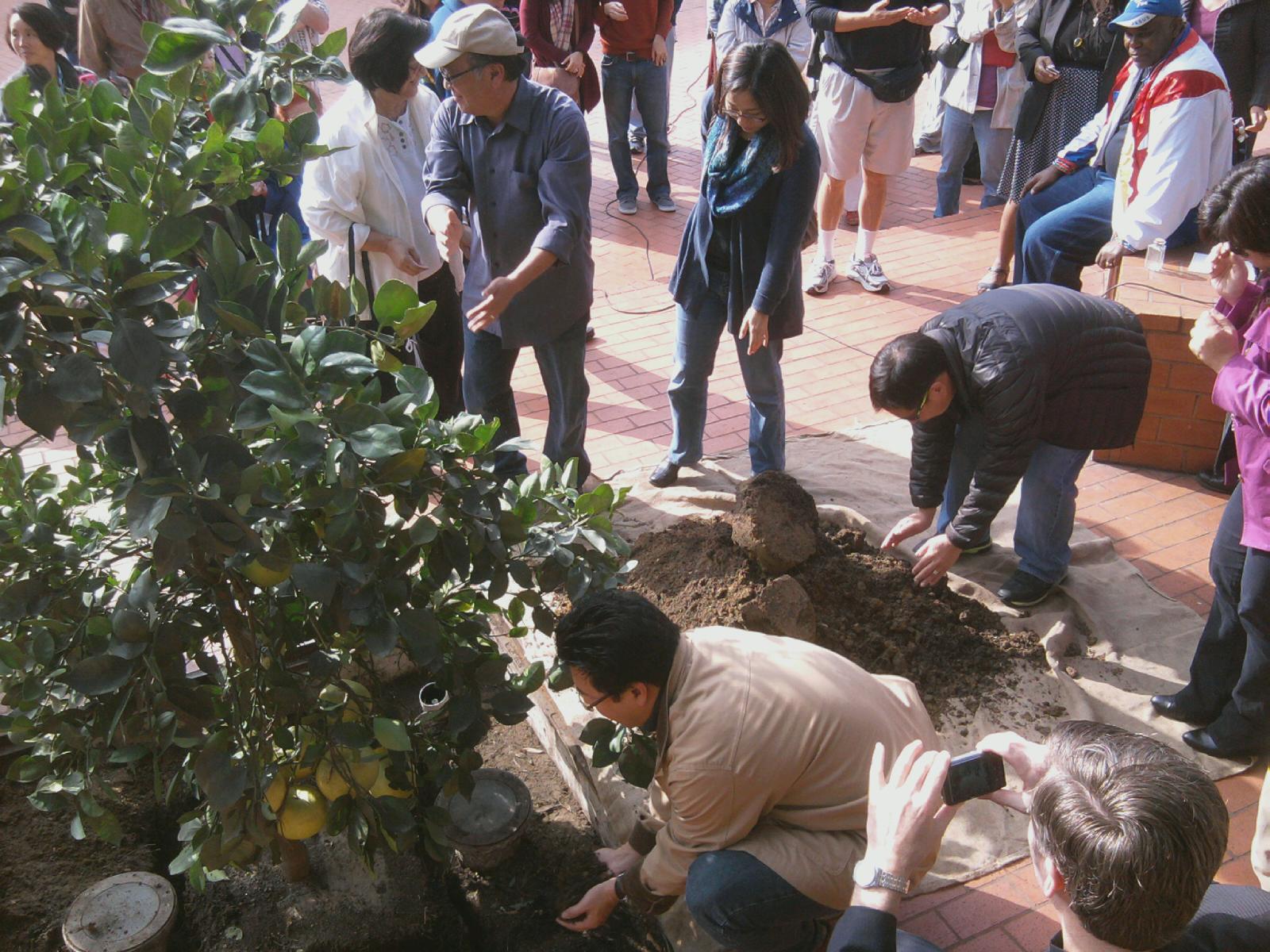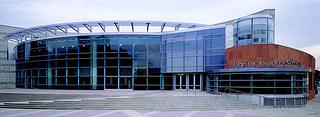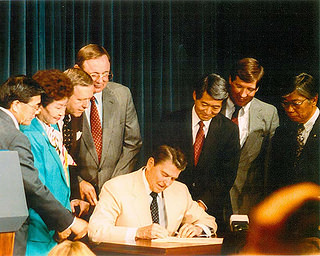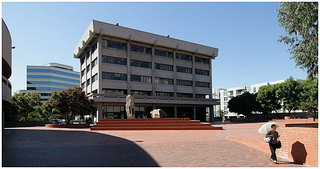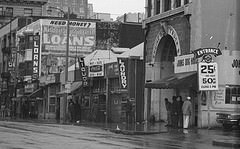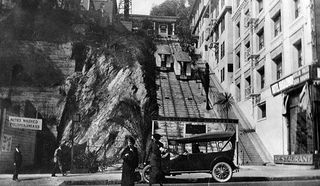Mural Timeline
-
December 8, 2012
Grapefruit Planting Ceremony on Azusa and San Pedro Streets
On December 8, 2012 at the corner of Azusa and San Pedro, several community groups came together to plant a grapefruit tree to replace one that had been lost. Japanese Americans, Skid Row community activist, Native Americans, Azusa Street Revival members and Pentecostals came together to celebrate this new tree together, inviting everyone to participate by adding a scoop of soil to the newly planted tree. In 2004, the last remaining tree from when the site was a fruit orchard was accidently killed with hot cooking oil. It was a 125-year-old grapefruit tree, which still bore fruit and was beloved by the local communities. This planting ceremony marks an important time of community-building and community-bridging along Azusa Street. At this time, Los Angeles had 3,857,799 residents.more -
January 1, 1992
Japanese American National Museum Opens
Located on N. Central Ave. and E. 1st Street, the Japanese American National Museum opened in 1992 with the mission to promote understanding and appreciation of America’s ethnic and cultural diversity by sharing the Japanese American experience. Built by Japanese immigrants in 1925, the Japanese American National Museum’s renovated historic building was the first structure designed specifically in Los Angeles to house a Buddhist place of worship, the Nishi Hongwanji Buddhist Temple. It is located less than a mile from Azusa Street, walking west along 1st Street. The Japanese American National Museum is the first museum in the United States dedicated to sharing the experience of Americans of Japanese ancestry as an integral part of U.S. history. Through its comprehensive collection of Japanese American objects, images and documents, as well as multi-faceted exhibitions, educational programs, documentaries and publications, the National Museum shares the Japanese American story with a national and international audience. At this time, Los Angeles had 3,485,499 residents.more -
August 10, 1988
The Civil Liberties Act of 1988
In the 1980s, the third-generation youth joined the Nisei in seeking redress for the injustices suffered by the internees during the war. The lengthy struggle ended in the passage of the Civil Liberties Act, additionally known as the Redress Law. The Civil Liberties Act of 1988 granted reparations to Japanese Americans who had been interned by the United States government during World War II. The act granted each surviving internee about $20,000 in compensation, with payments beginning in 1990. The legislation stated that government actions were based on "race prejudice, war hysteria, and a failure of political leadership" as opposed to legitimate security reasons. A total of 82,219 received redress checks, including residents of Little Tokyo.more -
January 1, 1980
Japanese American Cultural and Community Center is Established
Located in Little Tokyo, the historic heart of the Japanese American community, the JACCC was the dream of visionary Issei and Nisei (first and second-generation) Japanese American pioneers to create a permanent center for the community where arts and culture come alive and can flourish for future generations. The JACCC has its roots in the early 1970's redevelopment of Little Tokyo, when a citizens advisory committee determined that one of its first priorities was to build a cultural and community center. With the support of the Community Redevelopment Agency (CRA) of Los Angeles and other lead funders, the JACCC’s Center Building was opened in 1980. This was followed shortly thereafter by the opening of the Japan America Theatre and JACCC Plaza, respectively, in 1983. Construction on the JACCC’s facilities took place between 1978 and 1983 at a cost of approximately $15 million. The initial capital campaign to build the JACCC was launched in 1976 and largely completed by 1983 with the participation of the Japanese American community, local governmental sources, U.S. foundations and corporations, and Japanese businesses, both in the U.S. and Japan. A final push to retire the remaining building debt of approximately $1 million was completed in 1989.more -
January 1, 1975
Redevelopment Plan of 1975 and Skid Row
As development began and industrial markets grew — particularly the flower and fashion districts adjacent to Skid Row — the need to “improve” Skid Row arose. Various groups consistently initiated efforts to improve the community. In 1975, a Redevelopment Plan was adopted, which included a “Policy of Containment.” This policy concentrated social service agencies and people experiencing homelessness in one section of the city, where many of them naturally congregated. The goal of the policy was to stabilize and centralize the area to make services more accessible, not to crowd the area with people experiencing homelessness or fence them in. Since 1975, there have been improvements in Skid Row in terms of services for people experiencing homelessness. Two parks in the area have been rehabilitated, nonprofit-owned SROs have moved into the area, and many service facilities have been renovated and/or relocated. In addition to infrastructure redevelopment, service providers are recognizing a need to rehabilitate people — rather than just providing meals and beds. Several shelters — including Union Rescue Mission — provide 24-hour services (rather than overnight only), rehabilitation programs, and a safe place for people during the day. There may be several definition of the boundaries of Skid Row, but the one we see to be most accurate and widely accepted is 3rd and 7th Streets, to the North and South, and Alameda and Main, to the East and West, respectively.The image on the left is of the 200 block on East 5th Street in the 1970s.more -
January 1, 1970
LA in the 1970s
In the 1970s, the population in Los Angeles was 2,816,061. The image on the left shows downtown Los Angeles and Dodgers Stadium, taken in 1970s. US Census Bureau charted steady growth in Los Angeles from the 1930s to the 1970s, with 350,000-400,000 new residents every ten years.more -
May 18, 1969
Closing of Angel's Flight
Angel's Flight railway was credited as "the world's shortest railway" and was 2 street blocks long. It was located less than two miles northwest of Azusa Street and assisted residents traveling up the steep 33% incline of Bunker Hill. The railway closed on Bunker Hill to make way for the massive redevelopment project in the Bunker Hill region of Downtown. It was designated as Los Angeles Historic-Cultural Monument in 1962 before it was dismantled.more -
January 1, 1965
Department of Water and Power Building is completed
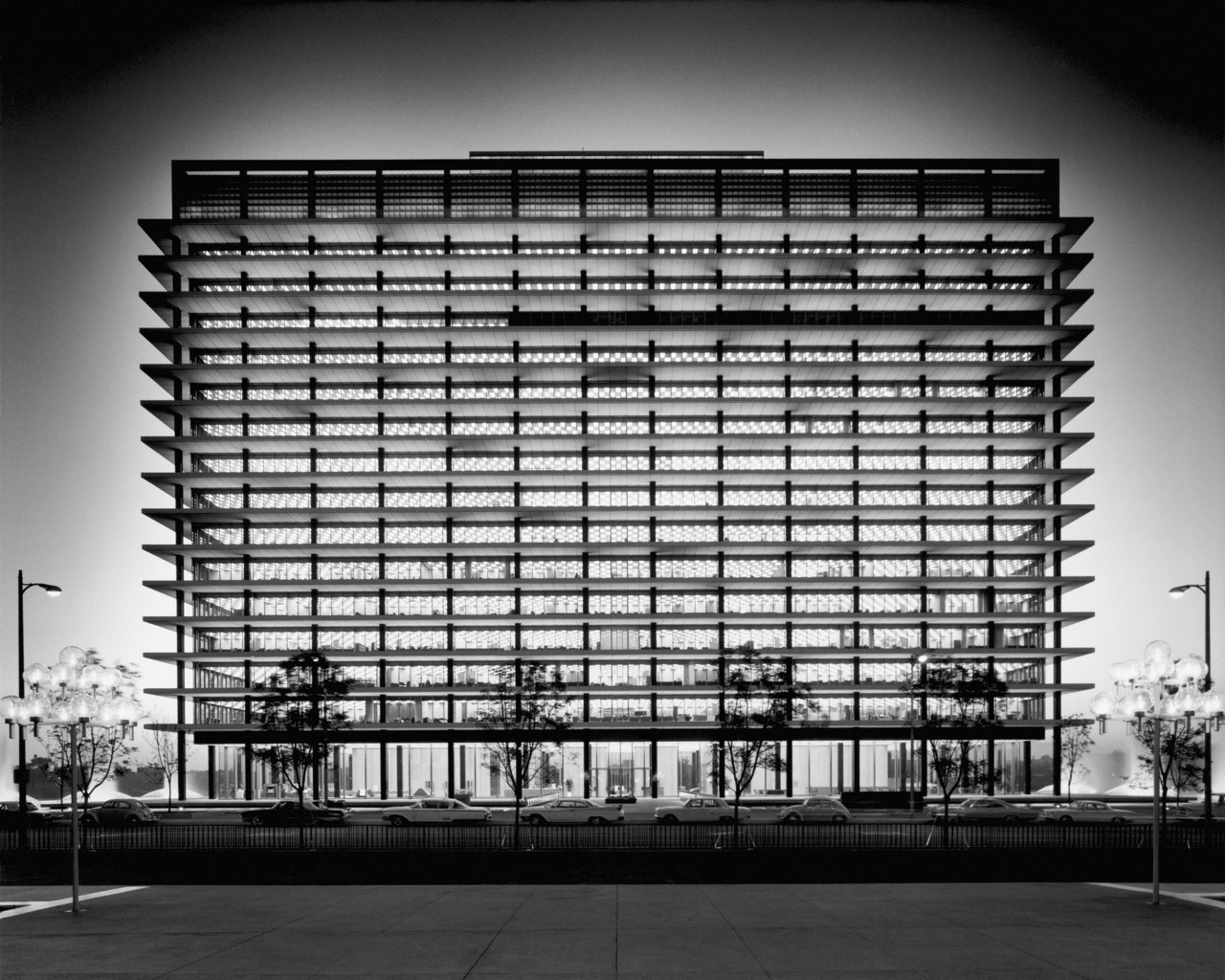 Located less than one mile north of Azusa Street, one of the most iconic buildings in downtown Los Angeles was built and completed in 1965. Designed by A.C. Martin architects, the Department of Water and Power Building, also known as the John Ferraro Building, has left it's mark on the visual aesthetic of downtown.more
Located less than one mile north of Azusa Street, one of the most iconic buildings in downtown Los Angeles was built and completed in 1965. Designed by A.C. Martin architects, the Department of Water and Power Building, also known as the John Ferraro Building, has left it's mark on the visual aesthetic of downtown.more
-
January 1, 1962
The East Los Angeles Interchange
 Considered on of the largest interchange of freeways in the world, this interchange connects the Golden Gate Freeway, Santa Ana, Santa Monica Freeway, San Bernadino and Pomona freeways and is located about one mile northeast of Azusa Street.more
Considered on of the largest interchange of freeways in the world, this interchange connects the Golden Gate Freeway, Santa Ana, Santa Monica Freeway, San Bernadino and Pomona freeways and is located about one mile northeast of Azusa Street.more
-
May 8, 1959
Eviction of Chavez Ravine Residents
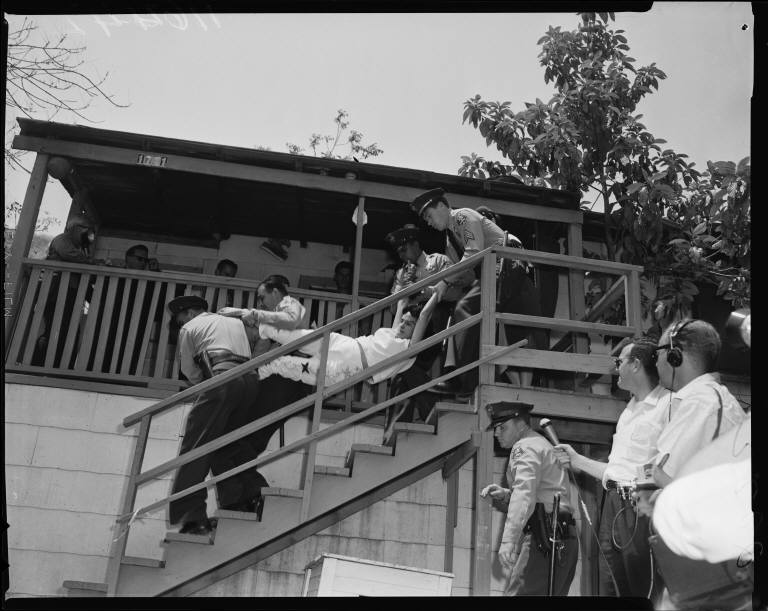
The fight to preserve affordable housing and prevent displacement is a historic one in Los Angeles, as it is across the nation. One of the most famous stories is that of the residents of the communities of Palo Verde, La Loma, and Bishop that made up Chavez Ravine, which is located 2.5 miles north of Azusa Street.
This tight-knit Mexican-American community near downtown was promised new and modern low-cost housing would be built on their land. The Housing Authority then issued eviction notices to the Chavez Ravine residents, promising the families that they would have first choice of the new housing once the development was completed. The Chavez Ravine residents who sold their property to the Housing Authority soon discovered that they had limited choices of where to relocate. Many residents chose instead to ignore the eviction notices and squat on their own property.
It was a time when the public was fed a steady diet of red baiting and racism as the House on Un-American Activities waged a destructive war on civil rights. The LA business power structure didn't care for the idea of spending millions on developing real estate for poor people only to give it back to them for a pittance. The city purchased the land at a huge discount in 1949. The single stipulation to the agreement was that the land had to be used for the good of the public.
In 1958 LA voters passed Proposition B, which gave the land to the Brooklyn Dodgers who were relocating to Los Angeles. On May 8, 1959 the LAPD arrested the remaining residents in Chavez Ravine, forcibly dragging many from their homes. Bulldozers began flattening every structure in their path. On April 10, 1962 the Dodgers played their inaugural game at the new stadium in Chavez Ravine.
The photograph on the left shows Los Angeles County Sheriffs forcibly evicting Mrs. Aurora Vargas, 36, from her home at 1771 Malvina Avenue in Chavez Ravine, which was 2.5 miles north of Azusa Street.
more



